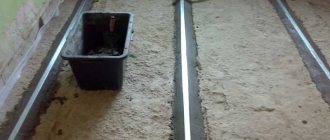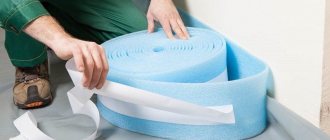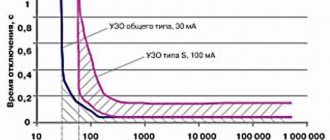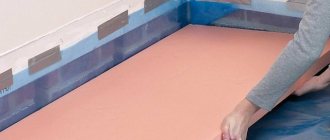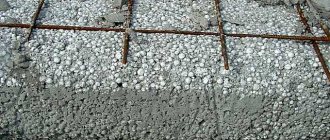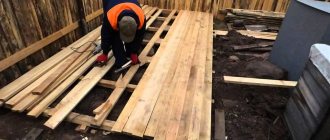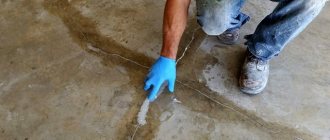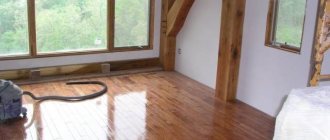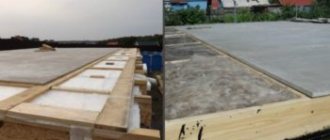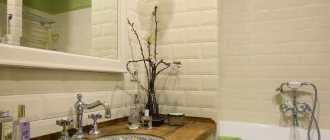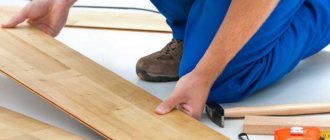Use of fittings
Construction reinforcement is strong enough to hold together the walls of a building, preventing further cracks from occurring. Despite this, such a technical operation will require certain skills, as well as the ability to use an electric welding machine. In addition, you will have to find the necessary information to correctly calculate the amount of reinforcement and its diameter. Calculations depend on the size of the building, as well as the nature of its damage.
Naturally, you can try and find all the necessary information, although it is better to involve an experienced construction organization. In this case, you will have to invest some money, but the calculations will correspond to a high professional level.
If the walls do not have serious damage, then in places where cracks appear, the brickwork can be replaced, and in cases of a high degree of destruction, it is better to use reinforcement, either reinforced or conventional.
Structure
A floating concrete screed consists of the following layers:
- plaster;
- finishing floor covering;
- cement-sand screed;
- a thick polyethylene film is covered so that the concrete solution does not leak into the heat-insulating material;
- expanded clay, mineral wool or polystyrene foam, polyethylene foam, performs the functions of a shock-absorbing cushion and heat insulator;
- damper tape around the perimeter of the walls more than 1 cm thick;
- floor slab.
The solution is poured onto a polyethylene film, which is laid on thermal insulation material. Concrete does not adhere to the surface of the ceiling and adjacent walls, and does not transfer shock and vibration loads to load-bearing structures.
What will it take?
In addition to the reinforcement itself, you will need some other materials, including tools:
- Fittings.
- Threaded studs.
- Nuts and washers.
The technology of screeding a house using reinforcement is not complicated. Metal corners with holes whose diameter corresponds to the diameter of the studs are installed at the corners of the house. Studs are welded to the ends of the reinforcement, after which the reinforcement with threads at the ends is inserted into the corners, which are installed on opposite corners of the building. After this, nuts and washers are screwed onto the studs, and then the nuts are screwed on. The structure is tightened by turning the nuts. Naturally, without a special wrench, this will not be possible.
How to eliminate cracks in concrete?
Cracks in concrete significantly impair the performance characteristics of the coating. The reasons for the formation of cracks are different, but in any case, repair work is necessary. Timely repair prevents the crack from spreading and debris and moisture getting into it:
- If there are a small number of cracks and the opening size does not exceed 2 mm, repairs can be limited to ordinary paint or polymer cement paste.
- If the amount of opening increases over time, use a polymer-cement composition or synthetic resins.
- In case of significant cracking, the injection method is used.
Important! The most reliable composition is obtained from a combination of polymer-cement and epoxy materials. First, the floor screed is grouted with glue (epoxy), and then mortar or polymer cement paste is applied over the fresh coating.
- To strengthen wide cracks, metal staples are used at intervals of 0.25 m in combination with a repair compound. Then the surface is rubbed using a single-rotor technique. It helps to mask all the roughness on the floor associated with the repair.
Quality of fittings and its types
Reinforcement is metal building elements that are used to form reinforced concrete building structures. The use of reinforcement and concrete makes the structure especially durable. In addition to reinforced concrete products, reinforcement is used in construction to strengthen various building structures.
The connection between reinforcement and concrete is carried out:
- By friction.
- By shift method.
- The method of adhesion of reinforcement elements during the concreting process.
- Electrochemical method.
- The method of compression with concrete after laying.
What kind of fittings are there?
There are several types of fittings, depending on the conditions of use.
There are different types of fittings:
- Straining.
- Unstressed.
And:
- Working.
- Assembly room.
- Anchor.
- Constructive.
Including:
- Transverse.
- Longitudinal.
As you can see, there are many types of reinforcement and it is very important to know which one to use in this case.
The essence of the process
Grouting the cement screed is the final stage of constructing a concrete foundation, aimed at leveling the finished surface. This process is performed:
manually - for rooms with an area of 25–30 m2; with a trowel (helicopter) - for processing large areas.
The screed is rubbed down so that the “concrete milk” that protrudes on the surface of the damp foundation does not peel off in the future.
As the cement mortar dries, heavy particles of crushed stone and grains of sand settle, and fine suspension and liquid come to the surface. They leave uneven and empty areas that reduce the performance of the concrete.
Grouting allows you to increase the adhesion strength of different particles, avoiding the occurrence of microvoids. This result is achieved due to the vibration-mechanical effect on the material.
Nature of house destruction
A screed for a building structure is necessary if the degree of its destruction can lead to further destruction of the integrity of this structure.
Typical types of destruction include:
- Collapse.
- Blockage.
- Separation of parts of a building.
Collapse of the structure
The collapse of a structure occurs as a result of the appearance of cracks in the upper part of the building, while the deformation of the walls occurs in the form of waves or can be observed over the entire surface.
This type of destruction can be partial or complete, when it is necessary to restore the integrity of all load-bearing elements of the structure. Partial destruction requires restoration of the functions of only some partitions.
Cracks in masonry. Tolerances; causes; How to make sure there are no cracks.
Important point! In any case, it is necessary to resort to a technological operation - screeding the walls in order to get rid of the destruction processes.
Damage to buildings can be light, medium, or severe.
Easy house collapse
Light damage is characterized by the appearance of cracks in half the corners of the openings with deformation of the wall heads by 1/3 of their height, while the condition of the foundation is normal.
Such destruction occurs due to the excessive weight of the roof, due to the construction of another floor, and also due to the lack of a reinforced upper chord. To eliminate this problem, it is necessary to mount a steel cage, tying the building structure at the corners.
The connection of the clip is carried out on the external walls. To carry out such repairs, it is necessary to prepare materials such as steel angles, pipes, studs, nuts, and steel rods. The work consists of connecting all elements using electric welding.
Average camber
The average type of camber is characterized by the presence of the same destruction as in the case of light camber, but their total mass is about 80 percent.
Such types of destruction may occur in the absence of a reinforcing belt, as well as in cases of loads exceeding the design ones.
In this case, you will have to tighten the walls of the house along the entire perimeter, laying tightening belts in 3 levels. It is permissible to replace steel reinforcement with a steel strip, and the quality of the welds must be high.
Strong collapse
A severe degree of collapse is characterized by the appearance of noticeable cracks both in the walls of the building and in its foundation, including all the characteristics inherent in light and medium destruction. As a rule, severe collapse is a consequence of the destruction of the foundation of the building.
It is important to know ! You can avoid complete destruction of the building if you use continuous support and corner supports, including strengthening the foundation.
The foundation is strengthened by laying a reinforced frame around the entire perimeter of the foundation.
Equipment used:
- Rotary trowelling equipment with electric or gasoline drive.
- Manual or automatic devices that distribute topping.
- Rotary blade machines, popularly known as “helicopters”.
- Edge technique, which is used to process screeds near columns or walls.
Device principle
There are single- and double-rotor troweling equipment. The machines differ in the way they are controlled:
- The operator controls the single-rotor machine using a long handle. The weight of the single-rotor device ranges between 35 and 70 kg, so it is quite portable and versatile.
Important! The advantages of single-rotor technology: mobility, convenience, maneuverability and good grout quality.
- The twin-rotor machine does not resemble a helicopter, but rather a small car. It is used over large areas. The main feature of control is the absence of contact between man and machine.
Important! Disadvantages: high cost and poor maneuverability.
Wall (edging) machines are convenient for working in corners, near walls, and in the area of doorways. Their feature is the small diameter of the working tool. This equipment is equipped with low-power electric motors, so the consumption of electricity is economical.
Working tool diameter
The main classification feature for trowels is the diameter of the working tool used:
- The universal diameter is 900 mm.
- In rooms with complex configurations and small areas, discs with a diameter of up to 600 mm are used.
Important! The finishing stage is carried out using bladed “helicopters” for grouting concrete with stiffeners. The blades cut off protruding sections of the screed. The floor turns out immaculately even and smooth.
- It is advisable to use equipment with a small disk in a room with columns and a large number of corners.
Important! For a spacious room, a two-rotor machine is optimal. The simultaneous operation of two disks allows you to process a large area.
House collapse: what is it?
The collapse of a house is when the walls of a building are piled inside the building. There are partial and complete blockages. In this case, all work is carried out inside the house using fittings that are welded together using electric welding.
A complete collapse is characterized by the collapse of three walls, regardless of the degree of their destruction. The reason for this problem should be considered a violation of construction technologies, as well as insufficient reinforcement of the belt. To eliminate this problem, you will have to use a powerful metal structure installed using through-fastening elements.
A partial collapse is characterized by damage that touches two walls. Repair involves installing a partial frame according to the principle of installing a continuous sheathing.
Video material
The use of specialized troweling equipment is the most progressive and inexpensive way to treat surfaces. After the finishing procedure, the floor is perfectly clean and smooth, even free of dust. The use of coloring compounds gives the floor an aesthetic appearance. The combination of work operations such as laying and grouting the floor screed helps reduce construction time. Another advantage of technology using topping is its versatility and the ability to be used on different objects.
Annex department
As a rule, a combined separation of the house extension occurs, and the main symptom is the appearance of a crack at the junction of the connection between the extension and the main building along the inner corner.
The main reason is that there is no rigid connection of the extension to the house or the presence of an unreliable foundation, as well as the excessive weight of the extension, which leads to overloads. It should be noted that it is not always necessary to strictly link the extension to the main building.
About a floating screed with your own hands
I recently read an article where the author argued that if you hire a team specializing in semi-dry screed, you run the risk of becoming amateurs and it is better to do semi-dry screed with your own hands.
I don’t agree, because it’s easy to distinguish amateurs from professionals by their equipment for semi-dry screeding. It is expensive and hardly feasible for a team of hacks. But be that as it may, the technology of the work itself on installing a floating semi-dry screed is the same, both for a professional team and with your own hands.
Manually
When grouting manually, you will need the following tools:
- Trowel is a type of trowel made of polished steel with a curved handle (can be replaced with a regular spatula). The length of an ordinary trowel does not exceed 22 cm, and the width is 17 cm. The length of the handle varies from 10 to 15 cm. A metal or polyurethane trowel. A rectangular tool with a wooden handle that looks like a plane. Its parameters: 12 by 16 cm. Grater. Narrower than a traditional grater (width is only 5 cm), but longer (20 cm). Container on wheels for even distribution of topping. Board to protect knees.
Additional processing
For additional protection of the floor surface from moisture, special polymer impregnating compounds are applied to the concrete surface. Impregnation clogs the smallest pores, binds microscopic particles of the top layer, which protects the concrete from dust and accidentally spilled aggressive liquids. Impregnation can be easily done with your own hands using a velor roller or brush, as shown in the video.
After completing all of the above technological operations, all that remains is to cut the expansion joints and seal them with special sealing materials. A high-quality concrete floor that can withstand significant loads is ready for use.
Types of grout mixtures
Most types of topping are based on Portland cement - a binder made from grinding cement clinker, gypsum and silicate additives. In the production of grout mixtures, solid fillers, polymer fibers, and modified impurities are also used. Various types of topping aggregates contribute to increasing the strength characteristics of concrete bases and abrasion resistance. For this purpose, steel fiber, crushed corundum, basalt, quartz sand and other mineral substances of high hardness are used.
For grouting bases that will subsequently be subject to high external loads, mixtures with the hardest corundum fillers should be selected. Such toppings are more expensive, but significantly increase the strength and durability of concrete. These mixtures are used in the construction of industrial facilities, parking lots, warehouses, and gas stations.
In the processing of concrete surfaces with subsequent operation under conditions of low and medium loads, toppings with quartz sand are used. Basically, such mixtures are used to seal the floors of small premises for residential, office, shopping and entertainment purposes.
Toppings for concrete floors
The polymer fibers included in the toppings serve as additional reinforcement for the top layer of the cement screed. Modified additives increase the resistance of concrete to external negative factors. Certain types of grout mixtures contain pigments that give the cement surface a certain color, increasing the decorative qualities of the floor.
Finish grout
Finishing grouting with a blade machine
The finishing grouting of the screed, as shown in the video above, is carried out by a helicopter with installed metal blades, which ensure optimal compaction of the surface without destroying the top layer of concrete.
The angle of installation of the blades increases from 5-10 mm during the first and second passes to 20-25 mm for the next two or three passes. Gradually the grouting speed increases.
It should be noted that it is impossible to perform high-quality finishing of the surface with your own hands using hand tools, so the use of troweling units is mandatory. High-quality concrete has a flat, smooth, almost glossy surface, as shown in the video above.
Conclusion
Pouring screed onto a wooden base has some peculiarities, but is quite possible on your own. The most important point is to create an intermediate layer between the wood and the cement, which will prevent them from further destroying each other.
Poured cement floor in a wooden house
The video in this article will provide additional materials. Follow the recommendations above and you will succeed!
Source
Scope of application
Leveling the concrete screed is necessary when pouring cement mortar into the screed:
in parking lots; in warehouses, hangars, production workshops; in shopping centers; inside social facilities and public places; in industrial buildings; in areas with high vibration exposure; in places where heavy vehicles are stored.
However, it is not recommended to trowel concrete in:
residential and domestic premises; premises where aggressive chemicals are stored; laboratories; premises where sterility is required.
Screeding timber walls and sealing cracks
It is not without reason that laminated veneer lumber has gained wide popularity - it is a relatively inexpensive building material with such advantages as almost ideal geometry, increased strength provided by the milled profile, and long service life. However, with all this, wood remains a natural material, which means that over time it still shrinks, albeit slightly, and cracks may also appear in it. A procedure called “timber screed” is designed to correct these shortcomings.
Calculation of the required amount of building materials
Calculations of the required amount of materials for the screed are carried out with the addition of + 15% of consumables (in case of additional needs). In order not to make a mistake in the process of preparing the purchase of material and not to overpay extra funds, it is best to contact a construction specialist for calculations, who will attach a sheet with the calculation operation performed to the work report and estimate.
The screed of a brick wall is calculated using the formula V = L x W x T , where:
- D – length;
- W – width;
- T – thickness.
Calculations are based on the building design. The area of the walls is calculated, the type of masonry, type of frame, and reinforcement pitch are taken into account.
Filling instructions
To achieve maximum uniformity and durability of the coating, it is necessary to carry out all work in one room in one go, with a difference of up to 2 hours. Otherwise, at the joints of different sections that harden faster, an area with reduced strength will form due to different moisture content. Manufacturers indicate mixing proportions on the packaging of their products.
The mortar is laid behind the doorway up to several centimeters. Along the boundary of the expansion joint, excess composition is cut off. Once the mortar has been laid, a grout trowel is used after 8-10 hours. If a pneumatic pump was used, the time is reduced to 3–4 hours, since grouting is done before the composition completely hardens.
When laying tiles, grouting with a trowel is not done.
The moisture content of the poured layer is maintained for 2 weeks after installation. In order not to reduce the strength of the layer, it is necessary to maintain the required level of humidity; the floor is covered with plastic film. It is spread over the entire area of the room with daily spraying from a spray bottle.
The film is removed after a week and the room is ventilated so that the humidity comes into equilibrium with the external environment of the room. When laying tiles on a surface, it is advisable to begin work after 3–4 weeks, and if you choose other types of coating, no earlier than 1 calendar month.
Wood plaster: how to plaster wooden walls inside a house?
Wood is an original Russian building material. From time immemorial, ordinary people built their homes from it. A log house is a visiting card of provincial Russia. Princes and boyars lived in stone chambers. The technology of insulating wooden housing and protecting walls from rotting has also come from time immemorial. Clay, straw, water and shingles for the wall are its main components. The name of the method is well known to every modern person - plaster.
